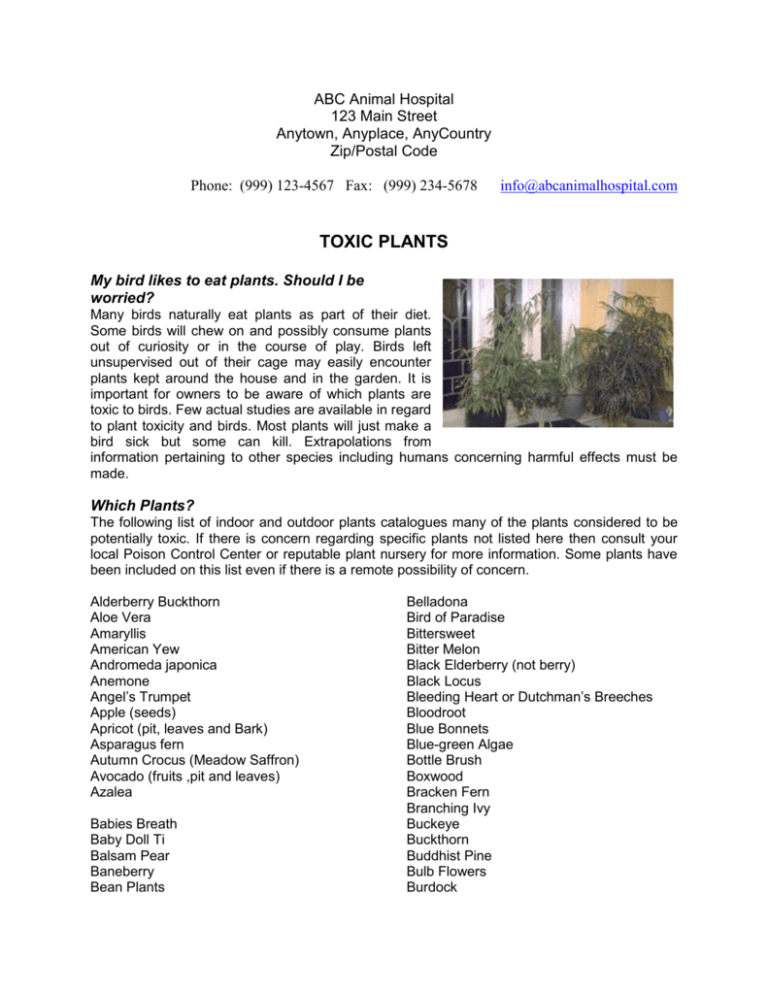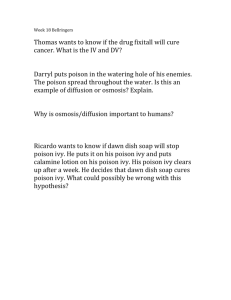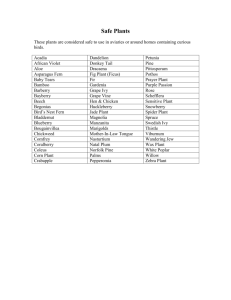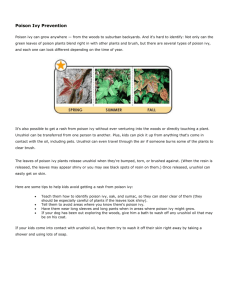toxic plants - Alpine Animal Hospital
advertisement

ABC Animal Hospital 123 Main Street Anytown, Anyplace, AnyCountry Zip/Postal Code Phone: (999) 123-4567 Fax: (999) 234-5678 info@abcanimalhospital.com TOXIC PLANTS My bird likes to eat plants. Should I be worried? Many birds naturally eat plants as part of their diet. Some birds will chew on and possibly consume plants out of curiosity or in the course of play. Birds left unsupervised out of their cage may easily encounter plants kept around the house and in the garden. It is important for owners to be aware of which plants are toxic to birds. Few actual studies are available in regard to plant toxicity and birds. Most plants will just make a bird sick but some can kill. Extrapolations from information pertaining to other species including humans concerning harmful effects must be made. Which Plants? The following list of indoor and outdoor plants catalogues many of the plants considered to be potentially toxic. If there is concern regarding specific plants not listed here then consult your local Poison Control Center or reputable plant nursery for more information. Some plants have been included on this list even if there is a remote possibility of concern. Alderberry Buckthorn Aloe Vera Amaryllis American Yew Andromeda japonica Anemone Angel’s Trumpet Apple (seeds) Apricot (pit, leaves and Bark) Asparagus fern Autumn Crocus (Meadow Saffron) Avocado (fruits ,pit and leaves) Azalea Babies Breath Baby Doll Ti Balsam Pear Baneberry Bean Plants Belladona Bird of Paradise Bittersweet Bitter Melon Black Elderberry (not berry) Black Locus Bleeding Heart or Dutchman’s Breeches Bloodroot Blue Bonnets Blue-green Algae Bottle Brush Boxwood Bracken Fern Branching Ivy Buckeye Buckthorn Buddhist Pine Bulb Flowers Burdock Buttercup Cadelabra Tree Caladium Calico Bush Calla Lily Cardinal Flower Castor Bean (Castor Oil Plant) Catclaw (twigs and leaves) Ceriman Chalice Vine or Trumpet Vine Cherry Trees (leaves, bark, seeds - Not pulp of fruit) China Doll Chinaberry Tree Chinese Evergreen Chinese Lantern Christmas Cactus Christmas Candle Christmas Cherry (berries) Christmas Rose Chrysanthemum Cineraria Clematis Coffee Plants Coral Plant Cordatum Corn Plant Cowslip Crocus Croton Crown of Thorns Crown Vetch Cyclamen Daffodil Daisy Daphne Datura (berries) Day Lilly Deadly Nightshade Death Amanita Death cap mushrooms Death Camas Delphinium Devil’s Ivy Dieffenbachia Dracaena Palm Dragon Tree Dutchman’s Breeches Egg-Plant leaves Elderberry Elephant’s Ear (Taro) Emerald Feather English Holly English Ivy English Yew Ergot Eucalyptus Euphorbia European Pennyroyal Euonymus Evergreen (most) False Hellebore Felt Plant Fiddle Leaf fig Fig (sap) Firethorn Flame Tree Flamingo Plant Fluffy Ruffles Fly Agaric Mushrooms Four O’clock Foxglove Fruit Salad Plant Geranium German Ivy Ginko Glacier Ivy Gladiola Glory Lilly Golden Chain Ground Cherry Hawaiian Baby Hawaiian Ti Heavenly Bamboo Heliotrope (leaves) Hemlock (Poison and Water) Henbane Hibiscus Hogwort Holly Honey Locust Honeysuckle Horse Beans Horse Chestnut Horse Nettle Horsetail Hurricane Plant Hyacinth Hydrangea Mountain Laurel Mushrooms (Amanita, other wild species) Impatiens Indian Laurel Indian Rubber Plant Indian Turnip Iris Ivy (Boston, English + some others) Narcissus Needle Point Ivy Nephthytis Nettles Nightshades Norfolk Pine Nutmeg Jack-In-The-Pulpit Japanese Yew Jasmine Java Bean (Glorybean) Jequirity Bean Jerusalem Cherry Jessamine, Yellow (leaves, stem) Jimson weed Jonquil Juniper Oak Oleander Kentucky Coffee Tree Lantana Larkspur Laurels Lily (many species, Oriental..etc). Lily-Of-The-Valley Lobelia Locoweed Locusts Honey Locusts, Black Lords-and-Ladies Lupine or Blue Bonnets Mandrake Marble Queen Marijuana May Apple or Mandrake Mescal Bean Mexican Breadfruit Milkweed Miniature Croton Mistletoe Mock Orange Monkshood Moonseed Morning Glory Tiger, Easter, Paradise Plant Parsnip Plant Parsley (in excess) Peace Lily Peach (pits, bark and leaves) Pear (leaves, seeds, bark) Pencil Cactus Pencil Tree Penny royal Peony Periwinkle Peyote Philodendron Pigweed Plum (pit, bark and Leaves) Plumosa Fern Poinsettia Poison Hemlock Poison Ivy Poison Oak Poison Sumac Pokeweed Poncirus Poppies Potato (new shoots, sprouts, leaves) Pothos Precatory Bean Primrose Primula Privet Purple Sesbane Ragwort Rain Tree Ranuculus Buttercup Red Maple Rhododendron Rhubarb (leaves) Ribbon Plant Rosary Peas Roseary Beans Rubber Plant Sage Sago Palm Sandbox Tree Schefflera Shamrock Plant Skunk Cabbage Snap Dragon Snow Flake Snowdrop Snow-On-The-Mountain Solomon’s Seal Sorrel Spurges Spindle Tree (berries) Spurges Star of Bethlehem String of Pearls (beads) Sweet Pea (plant) Taro Vine Tasy Ragwort Thornapple Tobacco Tobacco Tree Tomato Plant (green fruit, stem, leaves) Trumpet Vine Tulip Verbena Vetch Virginia Creeper Water Hemlock Wattle Waxberry Weeping Fig Western Yew White Cedar Wisteria Yam Bean Yellow Jasmine Yesterday, today, Tomorrow Plant Yews Yucca If in doubt remove the plant! Perches – Trees NOT to use apricot cherry peach prune plum nectarine This client information sheet is based on material written by Rick Axelson, DVM & Shawn Messonnier, DVM © Copyright 2005 Lifelearn Inc. Used with permission under license. March 7, 2016




